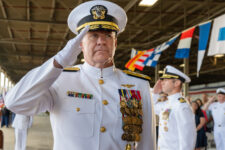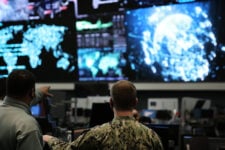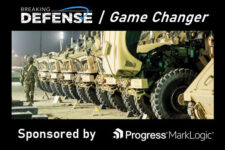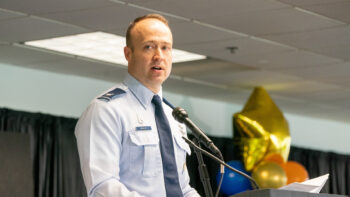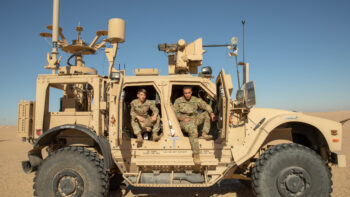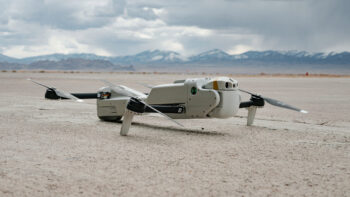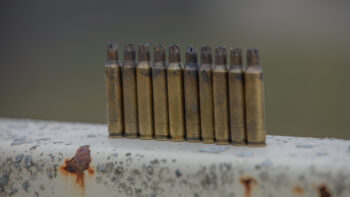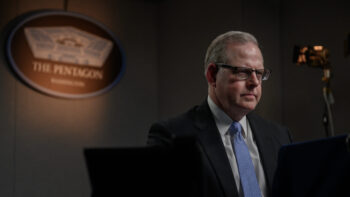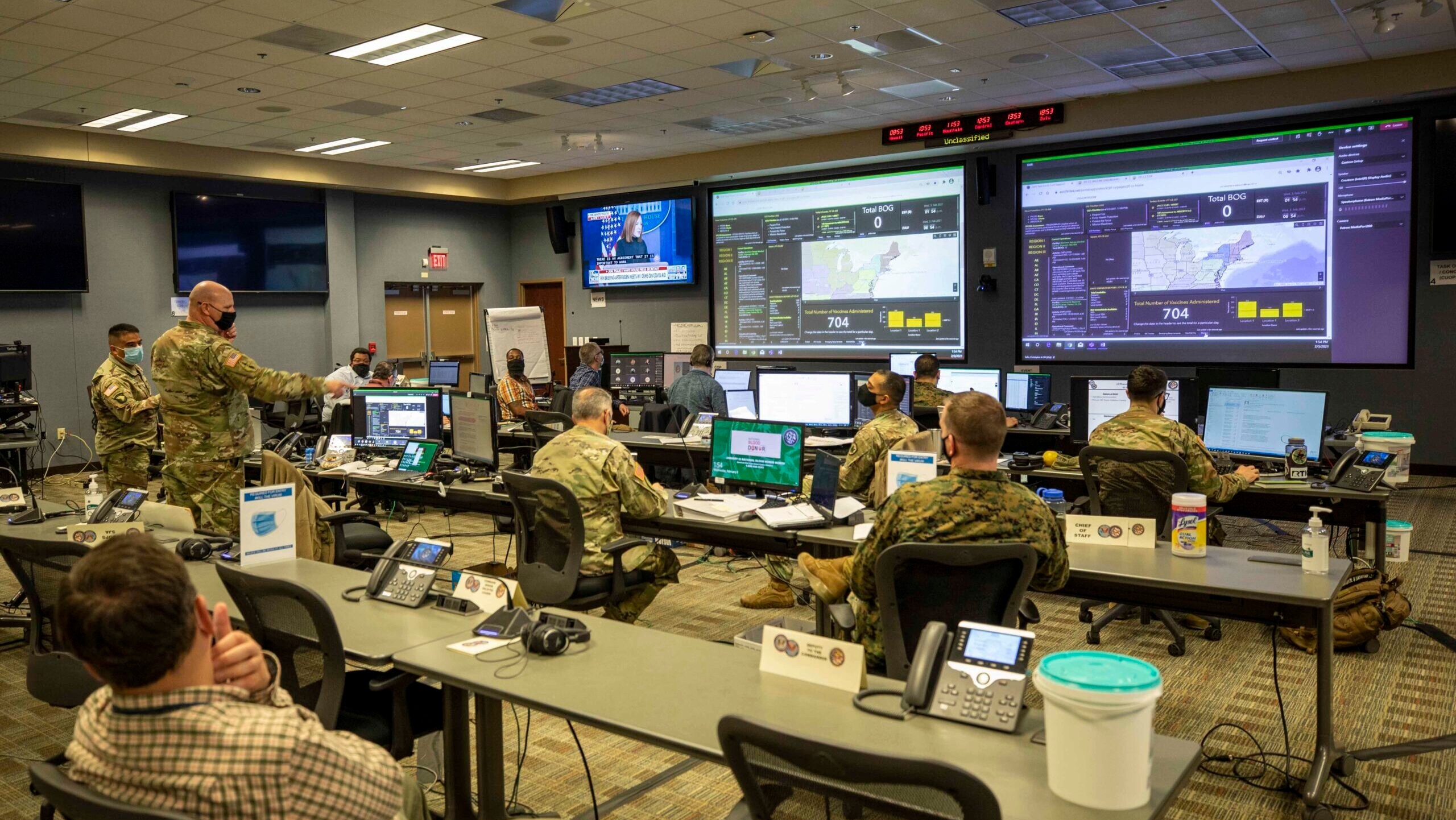
Army Col. Christopher Caldwell, the J3 operations director assigned to Joint Task Force Civil Support (JTF-CS), details the capabilities of the JTF-CS common operating picture to Commanding General Maj. Gen. Jeff Van and JTF-CS staff during a Joint All-Domain Command & Control System demonstration in 2021. (US Navy photo by Mass Communication Specialist 2nd Class Michael H. Lehman/Released)
WASHINGTON — The military services are collaborating more closely to make the Defense Department’s Combined Joint All Domain Command and Control (CJADC2) a reality — with a bit of pushing from above in the DoD food chain, according to Joint Chiefs Vice Chair Adm. Christopher Grady.
“I think increasingly the services are working together, although they have a different approach to it. But they are working together to bring capability that can be integrated,” he said today.
Speaking to the Center for Strategic and international Studies (CSIS), Grady explained that the Joint Requirements Oversight Council (JROC) — with the support of Deputy Defense Secretary Kathleen Hicks — has played a key role by leaning into both defining CJADC2 needs and following up to ensure service budgets are aligning with them.
CJADC2 refers to the Pentagon’s sprawling initiative to, in essence, link the military in such a way that critical information is taken in from anywhere in the world, assessed and passed along to the appropriate decision-makers at lightspeed — or, as the Pentagon likes to say, to “connect sensors to shooters.”
But currently different military branches are pursuing their own CJADC2 initiatives, each prioritizing their own connectivity needs. The Air Force has its (newly revamped and renamed) Battle Network that reaches through outer space, the Navy is working on its secretive Project Overmatch, and the Army’s effort is called Project Convergence. This has led to past concern there’s not enough “jointness” in the joint fighting concept.
OP ED: If CJADC2 is to ever happen, let INDOPACOM take the lead
Grady chairs the JROC, which is comprised of the service vice chiefs and is charged with setting the requirements for capabilities and kit needed by joint force commanders.
The JROC, he said, has a “well-written requirement for CJAD2” that was “intentionally written” as a broad document to allow the services some wiggle room in how to meet it — a requirement that the vice chiefs have validated not just once but twice.
“So, I’m comfortable where we are on the on the requirements side,” he said.
In addition, Grady added that he and Hicks “have instituted a steering committee to really start to pull this all together — and one of the things that that we, especially she, has been stressing is hey, we got to start talking about leave-behind minimum viable product.”
He explained this means that every time related exercises are undertaken — such as the latest all-service Global Information Dominance Experiment, GIDE 9, held in March — some real capability remains in the field for use by combatant commanders.
Hicks announced in February that DoD had built the first working version of CJADC2 that she called a “minimum viable capability.”
JROC Growing New Teeth
The evolution of CJADC2 has been driven in part, Grady explained, by the JROC’s own internal efforts to bolster its processes for shepherding joint requirements through the separate service budget processes — efforts begun under his predecessors in the vice chief’s job, Gen. Paul Selva and Gen. John Hyten.
Grady said that one of his key goals before leaving office in 18 months is “to continue the trajectory of the JROC and then to make it more effective, to put ‘teeth’ into the JROC.”
He noted that his counterparts in the British and Australian armed forces “have a hammer that they can drop upon joint questions,” whereas “the JROC does not.
“It can speak loudly, it can pull some levers of of influence, we could write a lot of product, but the services can do what they want. And so, how do we we change that dynamic to make it a little bit more compelling for the work that we do?” he said.
That said, Grady opined that in his view the JROC “are well on pace” in that effort.
One of the big changes already put into effect, he elaborated, is the fact that the JROC now looks at requirements from “the top down,” rather than only focusing on reviewing service plans for “widgets” and giving them the thumbs up or down. That top-down approach, he explained, is based on the Joint Warfighting Concept — and focuses on ensuring all the service equities are taken into account.
“So, this top down approach … that’s the first big step in the evolution of the JROC,” Grady said.
“The second is a portfolio approach,” he said. “In the past, there were too many widgets that we were talking about, lots of stovepipes. So, we’ve gone to capability portfolios, and that has been very powerful to break down stovepipes … and we’ve really ramped that up during my time.”
A third change helping the JROC, and the department as a whole, to keep everyone’s eye on the joint force prize is the new effort by Heidi Shyu, DoD undersecretary for research and engineering, to offer up possible approaches to filling requirements from her office’s “technology portfolios” effort that “is just getting out of the gates now,” he said.
“So, the triumvirate of those three together, and early [in the process], is adding a lot of a lot of momentum to the work that the JROC is doing,” Grady added.
Further, he said that he personally is working to cajole service leaders: “I have taken to directing the services to do things, and requesting the department to do things. It doesn’t mean they have to do it,” he said.
“There’s several ways to solve that — one’s to change Goldwater-Nichols,” he said, referring to nearly 40-year-old legislation that delineates between the mission of the services to organize, train and equip forces and that of the combatant commands to run actual military operations. “That’s a big lift, and not going to happen in my 18 months left.”
Another more feasible route, and one that the JROC is “spending a lot of time” on is ensuring the “trace-ability” of requirements, based on identified gaps in capabilities, and their fulfillment (or not) through the Program Objective Memorandum (POM) process of setting up the DoD budget each year through the next five years.
The JROC then reports back to the chairman of the Joint Chiefs of Staff and the DoD secretary with a kind of “scorecard” on how well those capability gaps have been filled, he explained, who in turn can, if they so see fit, go back to the services and tell them to “adjust.”
